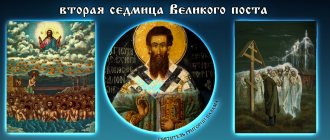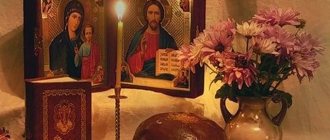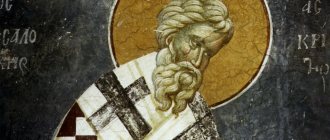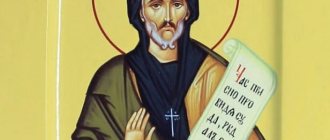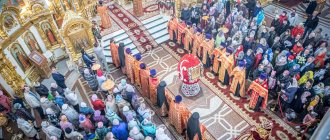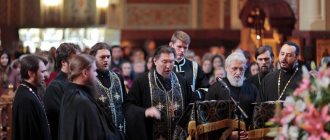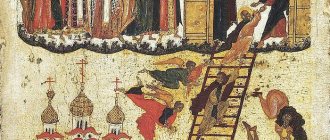History of the language
In the middle of the ninth century, the brothers Cyril and Methodius created the Slavic alphabet, called the Glagolitic alphabet. This alphabet was adapted to Slavic speech, but the letters used there are very unusual. They do not correlate with any other known language. According to the existing version, the Glagolitic alphabet was specially created for the presentation of church texts. But it did not become widespread in Rus'. In Croatia, services were conducted in this language until the 19th century, but in our country, already in the tenth century, there are almost no records in the Glagolitic alphabet. There is an assumption that it was used as a secret language. Another alphabet created by Cyril’s student, Clement, became widespread. It was he who began to be called the Cyrillic alphabet.
The Cyrillic alphabet began to be used to record sacred texts. This is how the Church Slavonic language arose. It was based on the Old Russian language. The differences were that Old Russian was spoken in everyday life, and Church Slavonic was used for prayers and communication with God. In those days, ordinary people understood it, although they themselves did not speak it. This was a different, “upper” level of language. Not for everyday matters, although understandable to everyone.
And then a split happened. Ordinary language has evolved and changed over time. Spoken speech changed, the spelling of letters changed. Church Slavonic remained unchanged. And ordinary people no longer understand him at the proper level. It is this problem that forces those who want to understand more deeply the words spoken by the clergy to begin studying the ancient language.
LEARNING TO READ IN SLAVICIn the 9th century, Saints Cyril and Methodius translated the Gospel into Slavic. Old Church Slavonic was similar to the Old Russian language; it was understood in Rus' without translation.
Here is a fragment of the Gospel in Old Church Slavonic and modern Russian. A translation of the Gospel in Russian was published in the middle of the 19th century.
| Gospel of Mark Chapter 1 1 The beginning of the Gospel of Jesus Christ, the Son of God, 2 As it is written in the prophets: Behold, I send My angel before You, who will prepare Your way before You. 3 The voice of one crying in the wilderness: Prepare the way of the Lord, make his paths straight. 4 John appeared, baptizing in the wilderness and preaching a baptism of repentance for the forgiveness of sins. 5 And all the country of Judea and the people of Jerusalem came out to him, and they were all baptized by him in the Jordan River, confessing their sins. 6 And John wore a robe of camel's hair and a leather belt around his waist, and ate locusts and wild honey. 7 And he preached, saying, He who is mightier than I is coming after me, whose sandal strap I am not worthy to stoop down to untie; 8 I baptized you with water, but He will baptize you with the Holy Spirit. |
35
Slavic letters
36
CROSSWORD
Vertical: 1. Capital of Ancient Rus'. 3. The name of the city in Macedonia, where the holy brothers Constantine and Methodius, educators of the Slavs, were born. 5. Bread that is blessed in church on Easter. 6. The name of the Patriarch of Constantinople during the life of the holy brothers Constantine and Methodius. 8. The head of the region in the Byzantine Empire during the life of the holy brothers. 9. What does the Greek word "sophia" mean? Horizontally: 2. Type of painting on wet plaster. 4. Writing material that was used during the time of Saints Cyril and Methodius. 6. What was the name of Constantine among the people? 7. What name did St. Cyril have before becoming a monk? 9. What was the name of the Byzantine emperor who sent Constantine to preach to the Slavs? 10. The name of the prince under whom Rus' was baptized. 11. Set of rules.
37
Answers
38
METHODOLOGICAL RECOMMENDATIONS FOR LESSONS ON THE TOPIC “ORIGINS OF RUSSIAN WRITING”
(Materials for lessons: in sections 1 and 3 of this collection, as well as in the textbook by N.G. Gorelova, B.I. Pivovarov “Native History”, Novosibirsk: “Ekor”, 1995)
Lesson No. I
| Dialogue with students, introduction to the topic. 5 minutes. | What is literacy? The beginning of national writing is the most important milestone in the history of every nation. The origin of Slavic writing. Names of the creators. The contribution of Russian literature to world culture. Historical sources. | See materials on pages 9-13 of section! of this collection. |
| Historical excursion. Orientation along the time axis. 10 min. | The desire for enlightenment by the faith of Christ led the Slavs to the need for a book language. Who are the Slavs? What do they have in common? Slavs in the 10th century What can become a unifying principle for peoples? | |
| Information on the topic of the lesson. 20 minutes. | Life of the brothers Cyril and Methodius. Konstantin the Philosopher. Translation of the word philosophy ('love of wisdom'). Enlightenment of the Slavic lands with the faith of Christ. Creation of the Slavic alphabet. Death of Konstantin (Kirill) and will to his brother. Translation of the Holy Books into Slavic by Saint Methodius. | A visual aid is an icon, see the intro on page 53 of this collection. |
| Add. material 10 min. | Prince Vladimir and the Baptism of Rus' | Page 72-79 textbook N.G. Gorelova, B.I. Pivovarov "Native History". |
| Lesson #2 | ||
| Basic information on the topic. 20 minutes. | Slavic alphabet. What alphabet did Constantine create? Cyrillic and Glagolitic. | Page 12 of this collection. |
| Slavic alphabet and Greek alphabet. Where do Greek words come from in our language? Tracing words. | See the article "Greek Around Us", page 18. | |
| Church Slavonic language and its role in the formation of the literary Russian language. . | See section 3, pp. 59-65. |
39
| Practical lesson. 20 minutes. | Reading some words in Slavic Text for the language, reading text in Church Slavonic, writing Slavic letters and numbers in a notebook. | For reading text, see page 35, lettering and numbers - pages 15-17 of the collection. |
| House. exercise | Learn the names of Slavic letters. | |
| Lesson #3 | ||
| Information on the topic. 35 min. | Memory of Saints Cyril and Methodius. Glorification of the holy brothers by the Orthodox Church (Feast Day May 24). Icon of Saints Equal to the Apostles Cyril and Methodius. | Icon - on page 57. |
| Hymn to Cyril and Methodius : listening to a tape or singing to piano accompaniment. | ||
| Celebrating the Day of Slavic Literature and Culture in Bulgaria. | See pages 33-34 of this collection. | |
| An ancient book. What were the first books in Rus', when did they appear, how and by whom were they written? In the 11th century, Rus' was one of the most literate countries in Europe. Yaroslav the Wise. High level of book art in Rus'. Love for the book. Decoration of ancient books. Charter letter. | Textbook N.G. Gorelova, B.I. Pivovarova “Native History”, pp. 261-266. | |
| Additional material. 10 min | Archive. Who are archaeographers? What is an archive, and what can its documents tell us? The first archives in Rus' (XVIII century). | Textbook "Native History", pp. 261-266. |
40
Church Slavonic numbers
The decimal system of numbers that we use today originated in India, although it is better known to us as “Arabic”. The Arabs, waging numerous wars, reached the borders of India and borrowed its number system.
Later this system spread throughout the world. In Russia, Arabic numerals began to be used in the 18th century. Until this moment, the role of numbers was played by letters, but with a special icon - a title. The title was placed above the first letter if the number was single-digit, or on the second letter from the end if the number was multi-digit. To mark a thousand, an oblique stick with two dashes was placed next to the letter.
Joy Found
It is very joyful to read on the choir.
Singers are often deprived of joy while singing, as they are preoccupied with hitting the notes, creating a dynamic and rhythmic ensemble, vocalizing sounds beautifully, and reading the interlinear text correctly. All these difficulties lead to the fact that often the singer simply has no time for prayer. May God grant the service to be sung well. But here's reading...
What joy and grace there is after the service for the reader (I know this, since I read it myself), if he reads a canon to a saint or a psalter with a tender, repentant and warm heart. What joy does a reader have when, through attentive, thoughtful reading, he can pray himself and help all parishioners pray.
In a sense, the reader on the choir with a generous hand distributes mercy - both to the singers, helping them in the service, and to the parishioners, helping them to pray. But the Lord said, “Blessed are the merciful, for they will receive mercy.” I am happy to think that our dear readers will find mercy from the Lord and will be pardoned forever and will find eternal joy in the unearthly kingdom of the great King.
The singer will sing on the heavenly choir...
How to learn to read Church Slavonic
Despite its apparent complexity, Church Slavonic is our native language. Many words have not changed their meaning and are perceived intuitively. But if you want to learn to read correctly, then you need to remember the following:
- As it is written, so it is read. Words are not shortened, they do not “eat up” endings.
- Some words are written in abbreviation. A special sign (title) is placed above such words. You need to remember these words.
- the accents often do not coincide with modern ones.
- Some letters are read differently depending on their position in the word.
Learn to read Church Slavonic during the six weeks of Lent
Hard signs, incomprehensible abbreviated words under titles, letters, although beautiful, are not always understandable... Not only children, but also adults often, barely looking at the Church Slavonic “tricky” lines, do not even try to read texts written in archaic Slavic graphics. Whereas these same words in modern Russian graphics are easy to read in Russian transcription.
If you think about it, the topic is amazing: after all, for a native speaker of the Russian language, “Church Slavonic is, although not a foreign language, but still another language, and yet no one would even think of reading in another language, for example, in English in Russian transcription – this is correct and normal!”[1]. Of course, if we are talking about reading prayers in Church Slavonic, here, of course, the most important thing will be prayer, turning to God. It doesn’t matter what language it’s in – it really doesn’t matter. Moreover, it does not matter with what icons the texts of clues and guidelines compiled by the holy fathers of our not Russian, not Slavic, but the Holy Catholic Apostolic Church will be written. Even Latin or cuneiform - as long as we pray, at least listen to the spoken words of prayers.
But if we read and sing prayers in Church Slavonic, it means that we love and honor this language. At least we accept the love and respect that our dear Local Russian Orthodox Church shows to this language. This means that it makes sense to try to learn yourself, to teach your children to read liturgical texts not only in transcription.
Study without studying: two in one
For the Russian-speaking reader, perhaps the only problem is to overcome the fear of Church Slavonic graphics
I wrote about how my children and I study Church Slavonic in a separate article. If the task is just to learn to read Church Slavonic, to imagine the structure and meaning of Slavic words and texts, learning can be very simple, it can develop almost by itself. After all, there is nothing tricky here: for a Russian-speaking reader who is familiar with the oral Slavic language, that is, knows some prayers in Church Slavonic and regularly repeats these prayers, perhaps the only problem is to overcome the fear of Slavic graphics. And here the solution is to just start reading. A solution tested by many people, children who, without much prior preparation, simply opened texts in Slavic one day and simply discovered: everything is clear, these are just special styles of familiar native words.
Of course, this “just start reading” is not always easy. To help those who want, but have not yet decided to introduce their children to reading Church Slavonic, it seems that we have managed to come up with a completely accessible ready-made solution. This year I tried to integrate an introduction to Church Slavonic graphics into our calendar for Lent, the calendar that we have been making by hand with our children for more than 12 years now and which, since 2022, has been published by the publishing house of the Pskov-Pechersk Monastery “Free Wanderer”.
Why did we change this calendar?
Firstly, I wanted some variety. If you make a calendar with your own hands - and handmade is always better, although more difficult - variety is included. And in the printed version it’s the same thing every year. I know that there are children for whom this is what is important: a reliable repetition of a familiar past. But there are children for whom it is very important to receive something new, and here is an update for them.
Secondly, I wanted to clearly highlight the past weeks of Lent. In general, in the calendars that we made ourselves, I highlighted the weeks that had passed. For example, there was this idea: at the end of the line-week, around Sunday, the children glued a piece of paper folded in half with some short useful text. At the end of the week, the sheet was folded back, the text was read - and so little by little, week after week, all the inscriptions were revealed. We also had another option - we prepared long strips of paper, the size of a seven-step step. Each strip also contained some kind of educational phrase. The week passed - it was sealed with this long strip. When I was preparing our calendar for printing, such long stickers seemed like an unnecessary bloat to me. But now, having lived with a ready-made calendar set for two years, I understood how to implement the countdown of past weeks. So the innovation is a visual highlight of the already lived days of Lent.
Thirdly, many parents asked me to increase the number of stickers in the set. There is no high ideology in this request: it turned out that in some families children want to stick stickers on the base of the calendar every day, or even worse - there are several children, and be kind to everyone with a sticker. To avoid accidents in those families where young children are not ready to humbly accept the lack of stickers, the number of stickers has been significantly increased.
It is not necessary to resort to a new use case for filling the calendar: the new use case is superimposed on the old one
And fourthly, the change in the calendar included that important matter that we are talking about today: new stickers help children learn to read in Church Slavonic.
At the same time, I would like to note: in general, the calendar is the same as last year and the year before. Those who do not want any changes can simply not contact the new option for filling out the calendar, designated in the instructions as the “second stage”: the new use option is literally superimposed on the old option.
How stickers will help you master reading Church Slavonic
The new option for filling out the calendar suggests that throughout Lent, every day the child covers the past day with a certain sticker - a window with the desired date. This sticker has a word (one or two) written in Slavic graphics. By the end of the week, these words will be used to compose a small phrase taken from the Psalter, and a circle will be glued to Sunday - a link to the corresponding passage of Scripture.
In the first days you will come across very simple words: in these cases, the Slavic spelling is almost identical to modern graphics, the meaning of these words will not require translation. Here is the word that a child will encounter on the first day of Lent: help. The only thing unfamiliar is the “tail” of the letter “ш”, which is not at the end, but in the middle of the letter. Any child who can at least somehow read Russian will easily read this Slavic word. And he’ll think or say out loud: “What’s so special about this, it’s just a beautiful (or crooked) inscription.”
Word for the next day: mine. What’s more difficult here is the unusually written letter “I”. It’s good to invite the child to understand for himself what kind of word this is, what kind of letter it is. If you can’t figure it out, the attached brochure contains line-by-line tips, transcription and translation of each phrase. However, most often children read words without prompting, and I’m sure it’s better not to show the page with the transcription to the child (maybe cut it out of the brochure?). If any difficulties arise, you should imagine the inscription on these stickers as a riddle, a rebus that needs to be deciphered. If you couldn’t decipher a word today, wait until tomorrow or even until the end of the week, when a whole phrase has been formed, and then try to decipher the entire phrase, finding out the meanings of the words and the correspondence of the letters from the context. This way you can learn to decipher and perceive words such as from, Lord (where) - presenting the word as a single image, like that same rebus or hieroglyph.
Of course, no one forbids you to first study the Church Slavonic alphabet, the rules for writing words - this is basically how children are taught to read and write in Church Slavonic. But I confidently say: most often it is more effective to start reading whole words and phrases. After all, we perceive a written set of letters, a word - as a single image, and this image evokes in our minds a reference to the semantic meaning of the word (here we can recall, for example, the well-known effect of typoglycemia; similarities in the future involve not only linguistics, but also such things as phliosphoia and psholgoiya... read? means, perceived words as images, and not as a sequence of letters). That is why many experts recommend teaching a child to read not by letters or even by syllables, but by short words. In such cases, the child draws a house and signs HOUSE, draws a family, signs PAPA, MOTHER, VANYA. Sometimes a child, without recognizing the names of the letters, writes HOUSE himself, realizing that this is exactly “house”, reading “house”: this way, gradually and quite quickly, the child masters reading and writing in his native - and not only native - language. This approach involves teaching language not analytically (decompose, parse), but figuratively (perceive words, phrases, sentences as images that have a certain meaning). I’m not trying to declare this approach to be the only correct one, I just want to say: such an approach exists, and in this case I rely on it.
Every day (except Sundays) the child reads one, maximum two Slavic words
So, every day (except Sundays) the child reads one, maximum two, Slavic words. He finds a sticker with this word based on the clues on a sheet of stickers from our set - the search already forces the child to pay attention to the inscription. Sticks - also draws attention. Then the word continues to remind itself of itself, because it is the last in the week-line on the calendar. This is why there is no transcription or translation on the stickers themselves: if you write a transcription, the child will involuntarily read the familiar, easy one - the transcription, and not the original word.
This is how a child learns the styles of Slavic letters and the spelling of whole words. Accidentally, without much effort, he learns to recognize words under titles and begins to perceive Church Slavonic orthography. There are, of course, not many words here, not all letters of the Slavic alphabet are used, very few words under the titles. But the main thing is that a start has been made. This is how the fear of reading in Church Slavonic is overcome. And, perhaps, the child will no longer be afraid, but even interested in reading prayers written in Slavic in the future.
Why are there no educational stickers for Holy Week?
As I promised in the title of the article, acquaintance with Church Slavonic covers only six weeks of Lent. This distinction reminds us that the seventh week is not considered Lenten. By the absence of stickers for Holy Week, we highlight this week as special: we fasted for six weeks, studied at the same time - and now it’s time to focus on the most important days of the year, on experiencing the events of Holy Week, on preparing for the main holiday of our lives. There is a time to study, including Church Slavonic, and there is a time to stop studying. Everything has its time.
This is just a set for creativity, a visualization of the Lenten path. But putting stickers on doesn’t mean fasting, of course.
And here I would like to remind both myself and the parents who make or buy our calendar: this is just a set for creativity, a visualization of the Lenten path. But sticking stickers does not mean fasting, of course. Seeing the path does not mean following it. With or without stickers, with a homemade calendar, a ready-made calendar, or no calendar at all - the main thing is to still try to introduce your children... not even to fasting, but to the difficult and courageous virtue of abstinence. Introduce them to church life, which, with its amazingly thoughtful structure, can lead both us and our children to a real, not a painted heaven. And a painted sky with a painted Lenten rock can only remind us of these tasks, of this – real – path. And I hope it will remind you.
